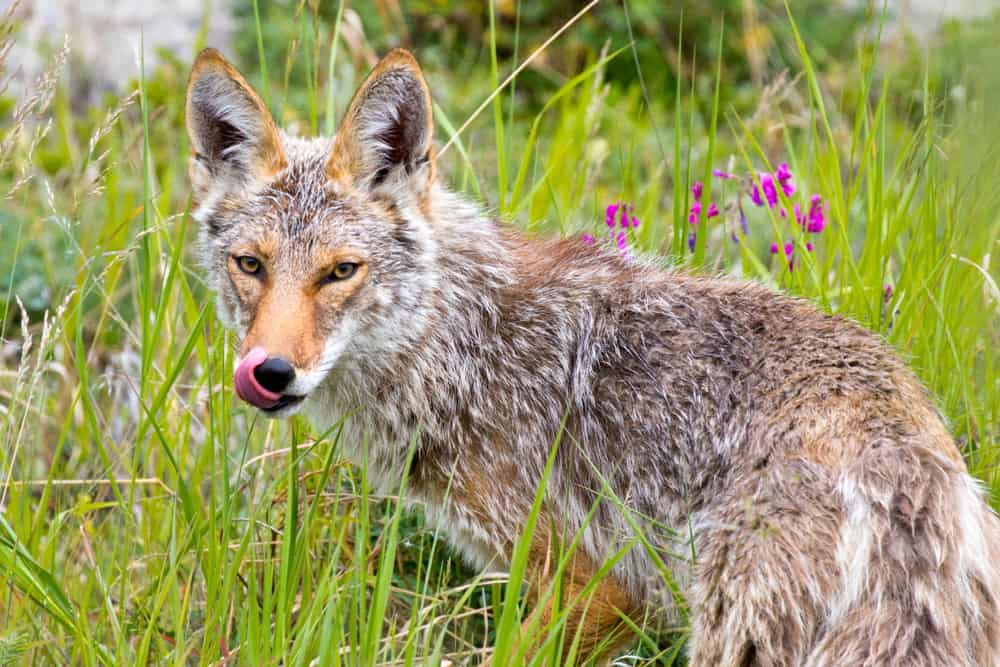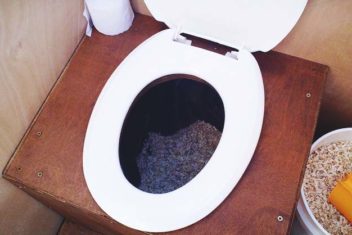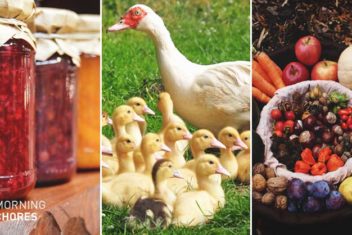Do you hear high-pitched yips at night and see shining eyes gazing at you from the underbrush? Chances are you’ve got some coyotes in the area. That’s to be expected: they’re prolific predators that are exceptionally good at surviving. They just don’t necessarily make the best neighbors.
Here’s how to deal with coyotes in ways that can benefit everyone involved.
Where Are Coyotes Common?
These canids are widely dispersed all over North and Central America. You’ll find them from Alaska to Costa Rica, and everywhere in between. Furthermore, they’re as common in urban environments as they are in rural locales.
Habitat loss due to urban spread has brought coyotes into cities and suburbs all over the continent. You might not catch a glimpse of them easily as they’re furtive, shy creatures, but you can bet that they’re present.
Are Coyotes Good or Bad to Have Around?
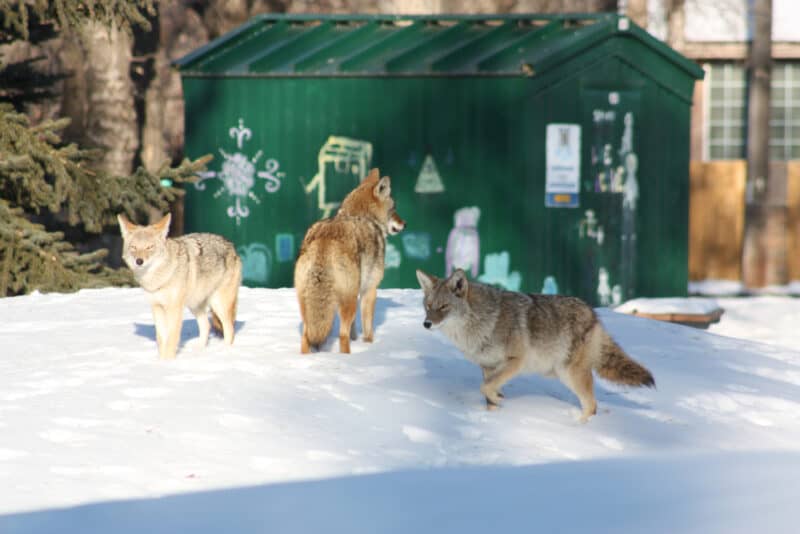
“Good” and “bad” are rather blanket terms that don’t take intricacies into account. They’re also highly polarized and dependent upon individual experience.
For example, someone who’s had trouble with coyotes preying on lambs or pet cats will consider coyotes to be the bad guys. In contrast, vegetable farmers who see a drop in rabbit, squirrel, and gopher damage to their crops will appreciate coyotes’ help in that regard.
These predators are known as “keystone species.” This means that their presence—or lack thereof—has a significant impact on the local ecosystem. Furthermore, their health or absence has a trickle-down effect on other species in the area.
You might not love the fact that coyotes have eaten your pet cats, but by doing so, the coyotes have undoubtedly saved countless wild birds from being killed by them. They’ll keep fowl populations (like grouse, wild turkey, and pheasant) healthy by eliminating nest predators, which means good things for seasonal hunters.
Additionally, these wolf cousins absolutely love to eat mice and rats, as well as voles, moles, and shrews. They’re some of their favorite snacks! If coyotes have made themselves comfortable around your home or outbuildings, you can be sure that they’ll keep the rodent population down hardcore. In fact, many people notice a huge boom in small rodent populations when coyote numbers decrease.
That’s a pretty good reason to keep them around, right?
Are These Predators Dangerous?
Not generally to humans. In fact, there are only two fatal coyote attacks on humans in recorded history. Although these canids will occasionally attack people, the attacks are rare and often understandable. For example, a starving coyote might try to eat a very small child who’s eating something alone outside, or a pack of urban coyotes might prey on a dying homeless man.
These aren’t malicious attacks, but rather just how these wolf cousins are wired. Wild canids cull juvenile, weak, and sickly animals like deer and such from herds. Since humans are animals too, they don’t really differentiate when it comes to the very small or the old and dying.
Additionally, rabid coyotes will attack just about anything.
That said, these animals generally try to keep their distance from humans. If you give one another a fair bit of respectful distance, and you take precautions to avoid enticing them, all should be well.
How to Live with Them in Harmony
One of the easiest ways to deal with coyotes is to take preventative measures. Much like when it comes to dealing with mice, if you don’t give them easy access to food and make the general environment inhospitable to them, they’ll look elsewhere for shelter and sustenance.
1. Make Your Property Less Appealing
If you think that coyotes are sheltering in old outbuildings or under piles of detritus, make those inaccessible. Lock up barns, discard or burn woodpiles (after chasing away any animals nesting in there, of course), and fence off any other potential den sites.
Keep grass mowed—they like tall grasses and shrubbery to camouflage into when hunting, so close-cropped grass isn’t appealing to them.
You can also get some wolf poop or urine from a local zoo or wildlife center and scatter it around the periphery of your property. Although coyotes and wolves will occasionally interbreed to create “coywolves”, the smaller canids usually keep their distance. Wolves are apex predators and will kill coyotes that they think are competitors for food resources.[1] Their scent is a good warning sign for coyotes to stay away.
Another idea is to rig up motion sensor lights. These animals hate loud noises and bright lights and will avoid areas where those tend to happen. Rig up some sensors that respond with bright floodlights or strobes and they’ll get the frig out really quickly.
2. Don’t Offer Them Easy Meals
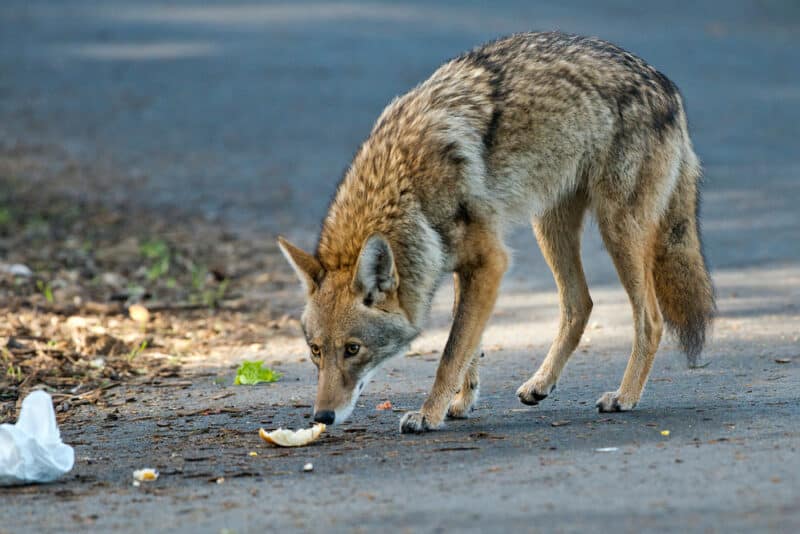
One reason why coyotes like to hang around homes and homesteads is that there’s abundant food to be had. And we’re not just talking about dozy chickens or oblivious house pets either.
Compost bins and garbage cans attract coyotes as well as raccoons. Keep your bins inside locked enclosures, and weigh or clamp the lids down as a secondary precaution. Don’t toss meat scraps into the underbrush, and if you have to bury dead pets or small livestock, pour quicklime over the bodies before covering them.
This will reduce the scent of decomposition and will accelerate the breakdown process.
Many people leave food outside for their pets or wild animal friends. Sure, it’s easy and convenient to put a bowl of kibble out for Fluffy to nibble on throughout the day, but those crunchy bites will smell just as tasty to passing coyotes. They’ll smell them from quite a way off and beeline for the snack bar. If they’re thirsty they’ll probably take a sip from the water dish too.
While they’re at it, they might notice that fat, lazy house cats and little dogs are looking pretty tasty. On that note…
3. Protect Your Animals (and Small Children)
The best way to keep coyotes from harming your animals is to set up better protections for them. This can mean providing outdoor animals with better fencing and keeping pets indoors.
Since we were just talking about pets, let’s focus on them first.
Yeah, barn cats are great for keeping mouse populations down in your outbuildings, but they’re really vulnerable to coyote predation. Furthermore, outdoor cats wreak absolute havoc on wild bird populations. If you absolutely have to let your cat outside, then make sure to bring it back indoors as soon as it starts to get dark.
Make sure to coyote-proof outdoor animal enclosures, especially chicken coops, rabbit hutches, and goat pens. If you let small dogs roam free in an outside yard, then make sure it’s fenced in well. You can also top tall fences with rollers. These prevent animals like coyotes, foxes, and large cats from being able to climb over the tops.
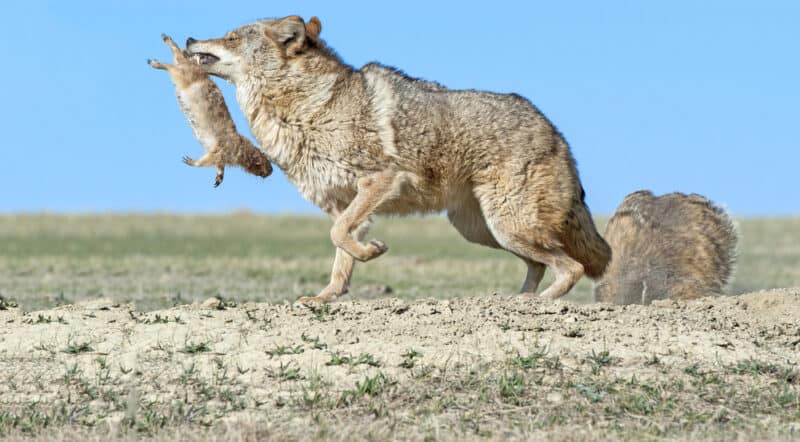
Don’t let small children play outdoors unattended, especially early in the morning, or after dusk. Additionally, you might want to teach some older ones what to do if a coyote comes a bit too close for their comfort. Early knowledge of self-defense and first aid can come in really handy.
4. Get a Guard Animal to Help Deal with Coyotes
Do you know how we mentioned that coyotes keep their distance when wolves are around? Well, they’ll also keep themselves to themselves when big, capable guard dogs are present. Some people like to keep alpacas or llamas around as guard animals, as they cause a ruckus and can be quite fierce too.
Personally, I’d recommend a dog over an alpaca any day, but that’s a matter of individual preference. Just make sure that you get a large breed that’s known to be protective, and can be trained well. Aim for shepherds and mastiffs over collies or retrievers.
5. What Not to Do
Please don’t try to harm the coyotes around you by poisoning or shooting them. If you take the preventative measures listed above, you should be able to live with them harmoniously. These animals are important species for local ecosystems, and as such deserve respect despite our perceived annoyances.
Remember that nothing in nature exists in a vacuum. Absolutely everything is interconnected, and they have a vital role to play too. As you’ve read here, there are numerous ways to deal with coyotes so they’ll cause fewer problems around your property.
If you follow all of the above recommendations and find that your still having problems with them, then call some humane animal control specialists to help you out. They should be able to trap and relocate the animals far enough away that they shouldn’t bother you anymore. The coyotes will still be able to play their part in the great circle of life, but leave your chickens and cats alone.
